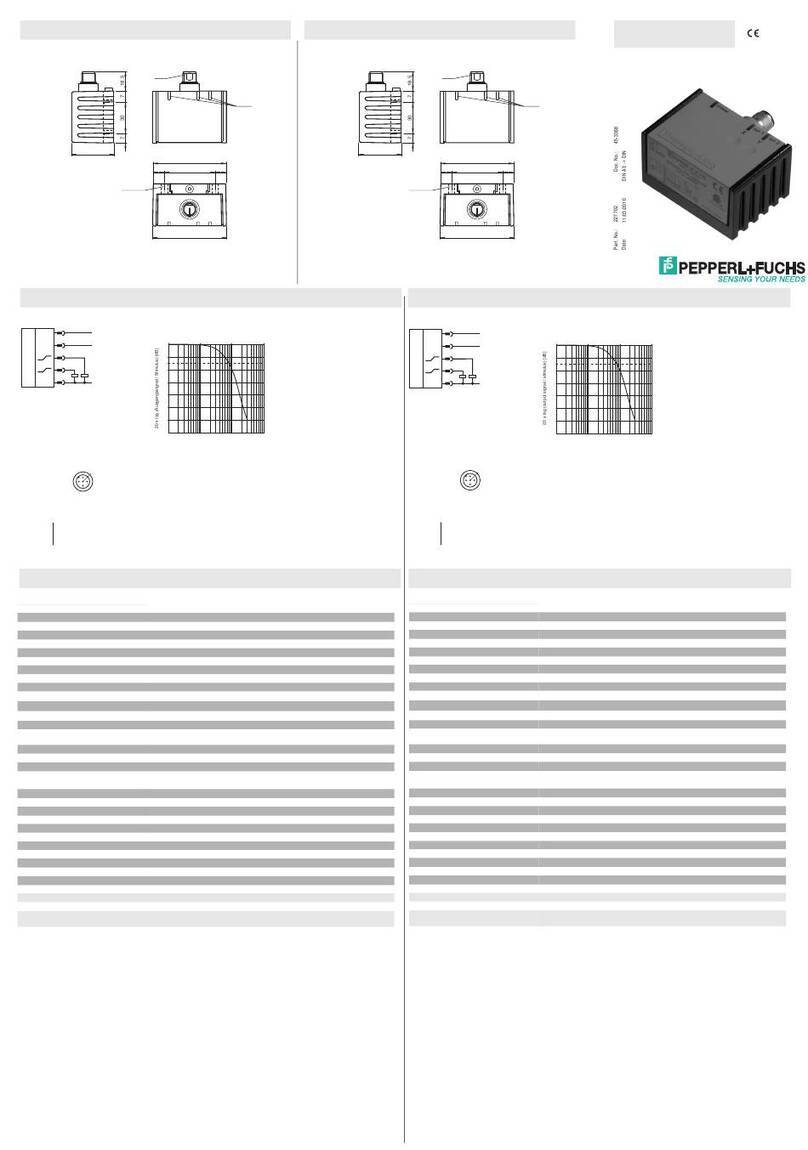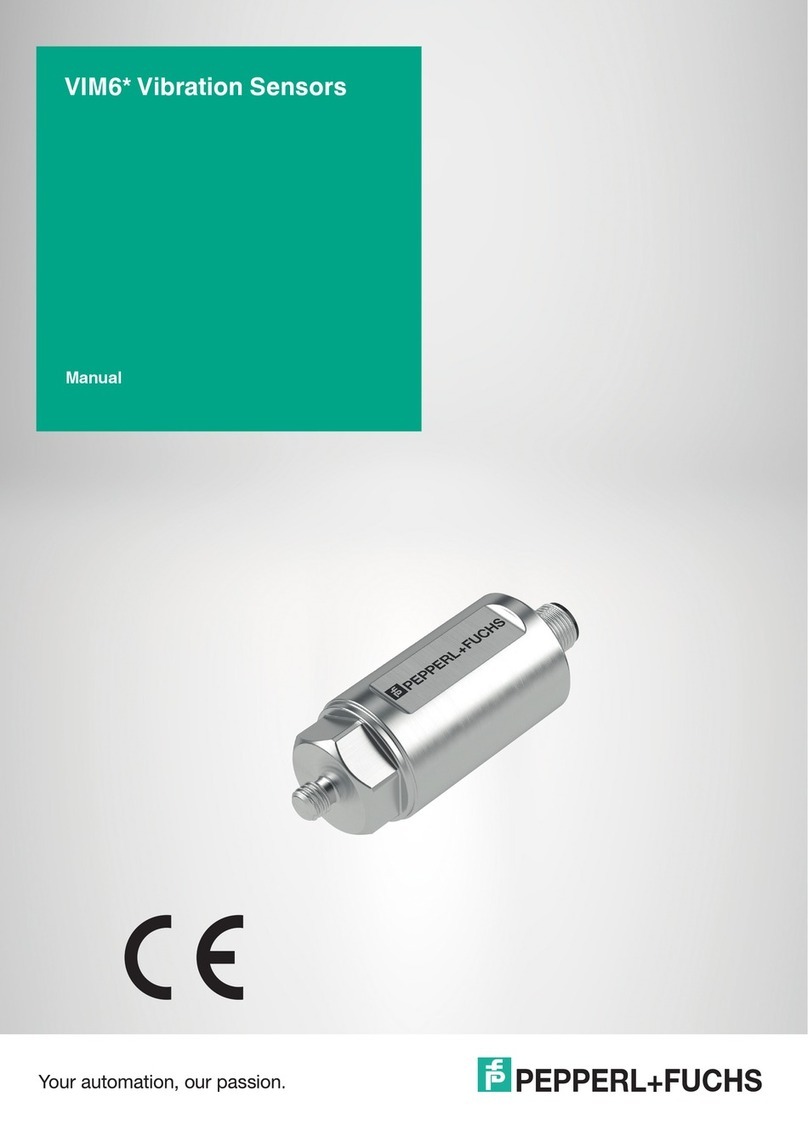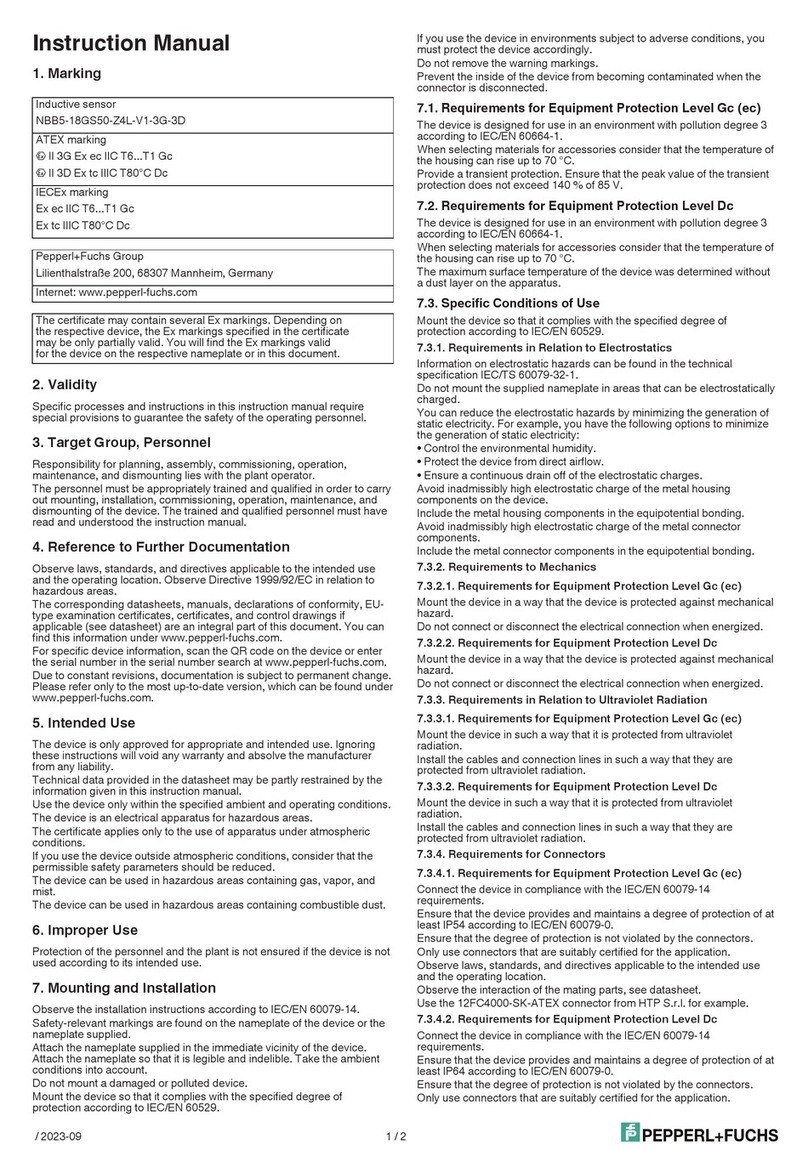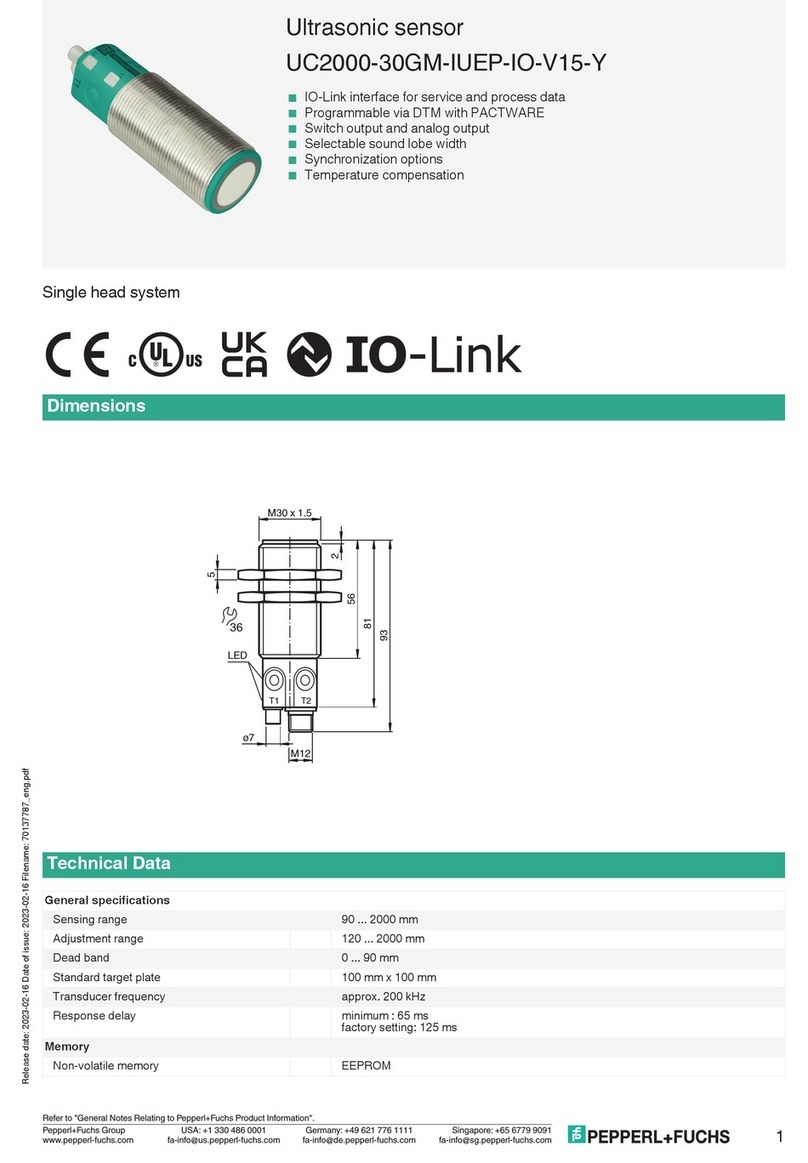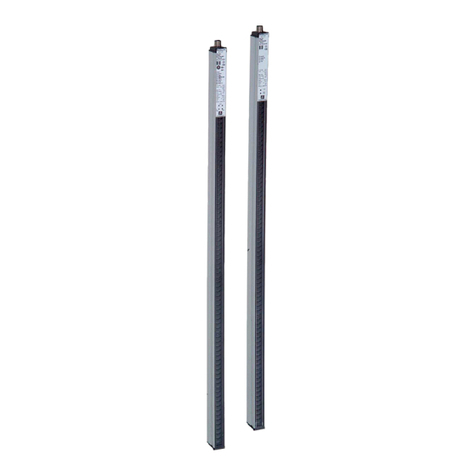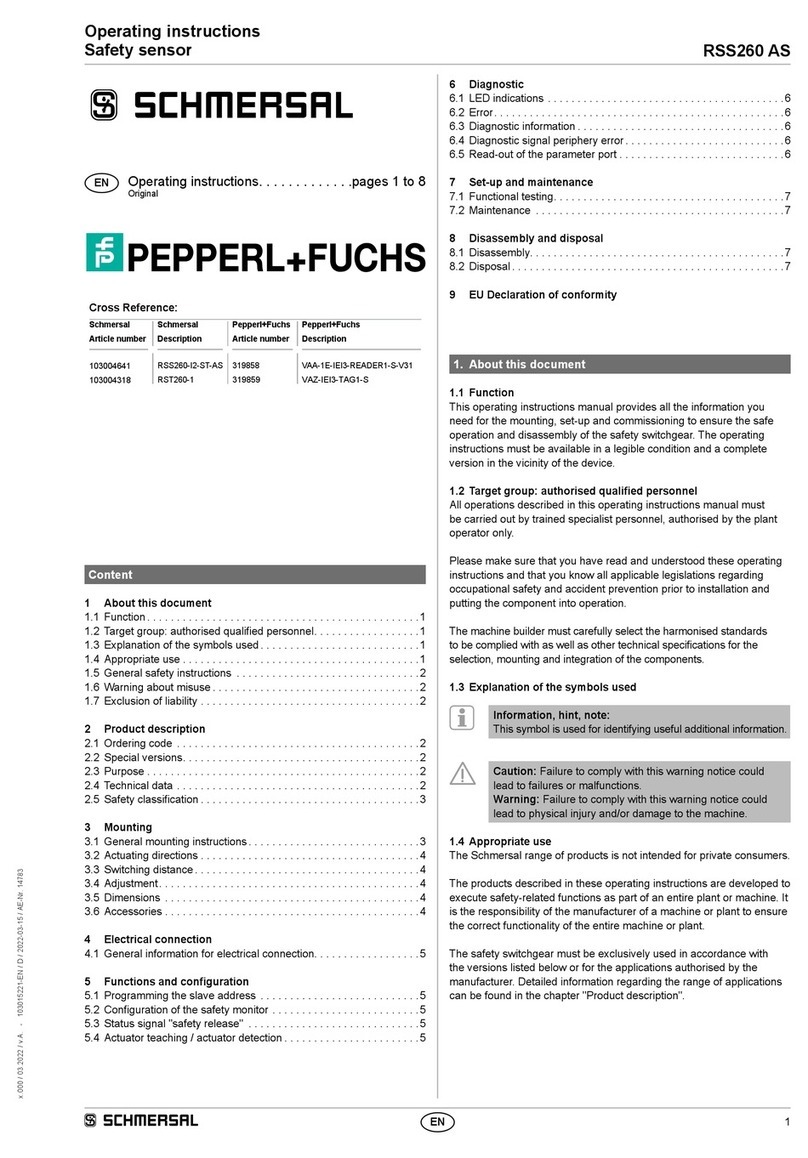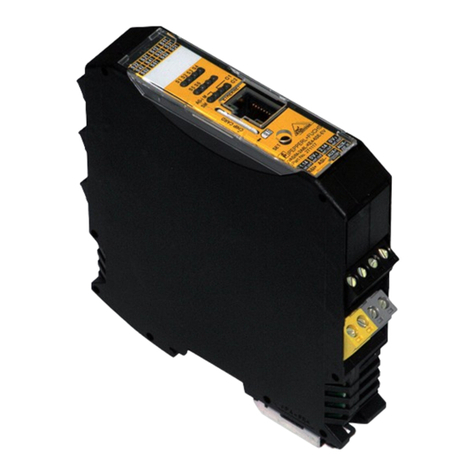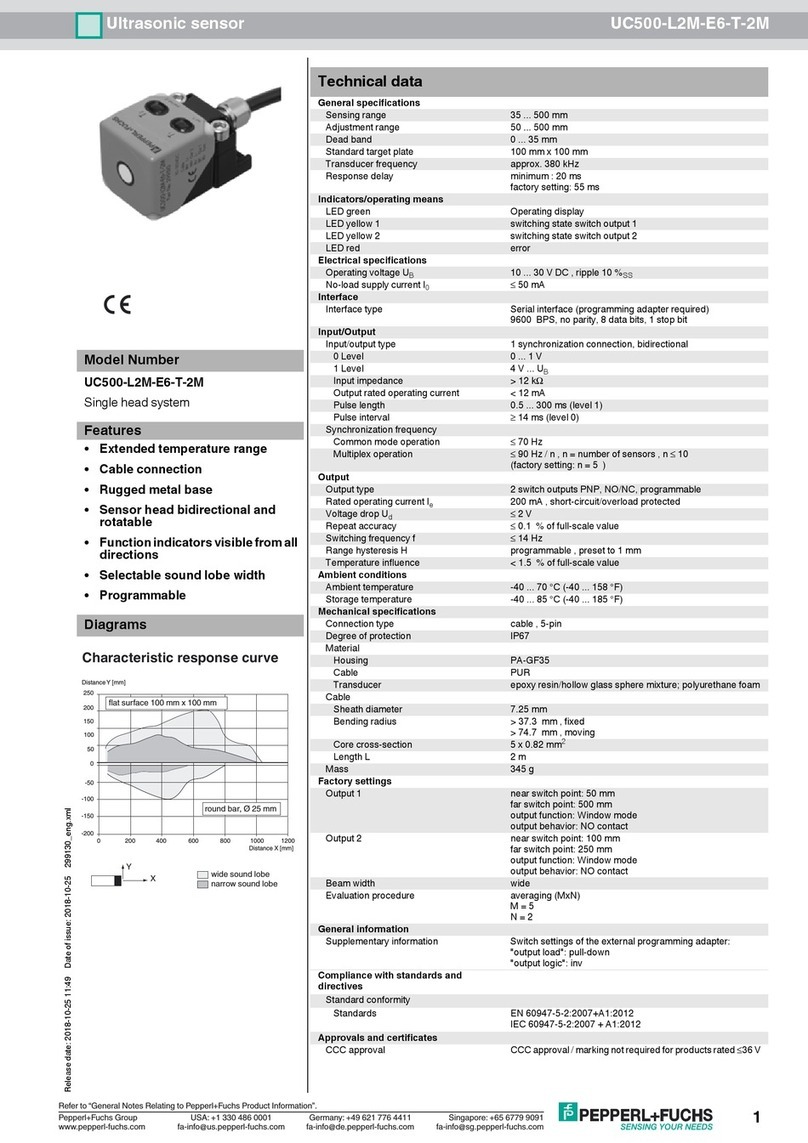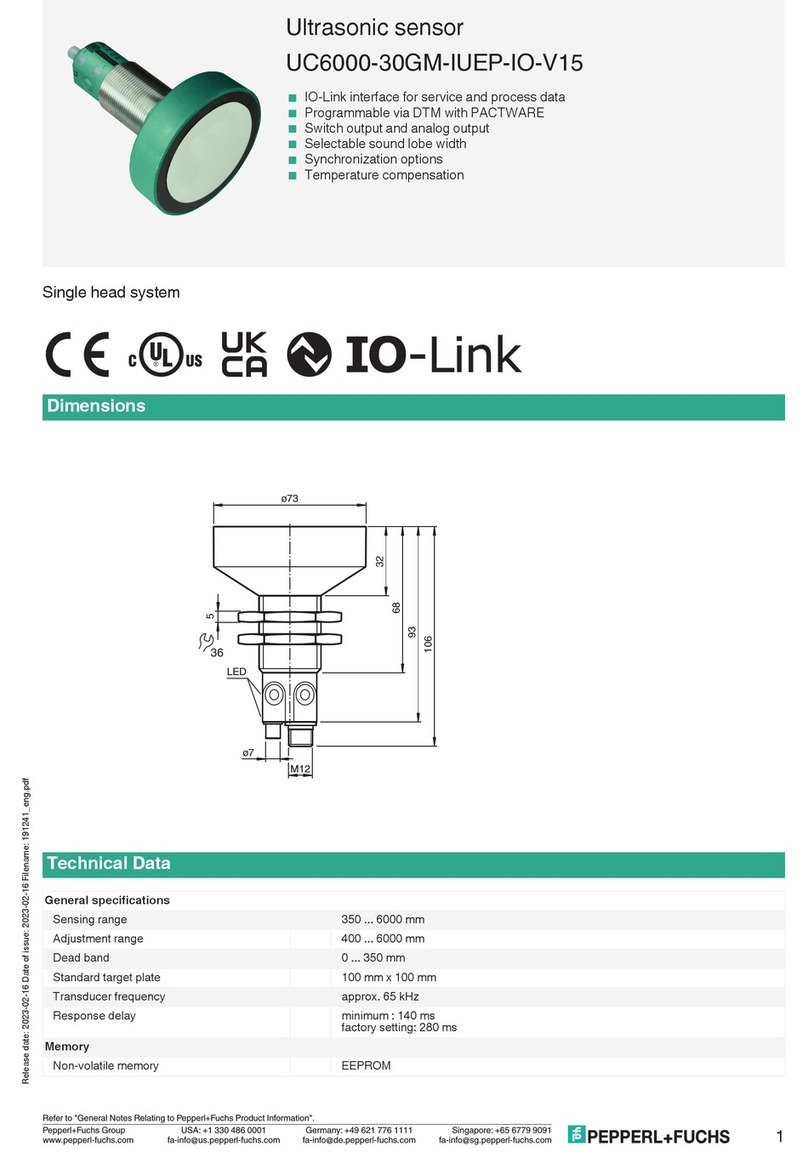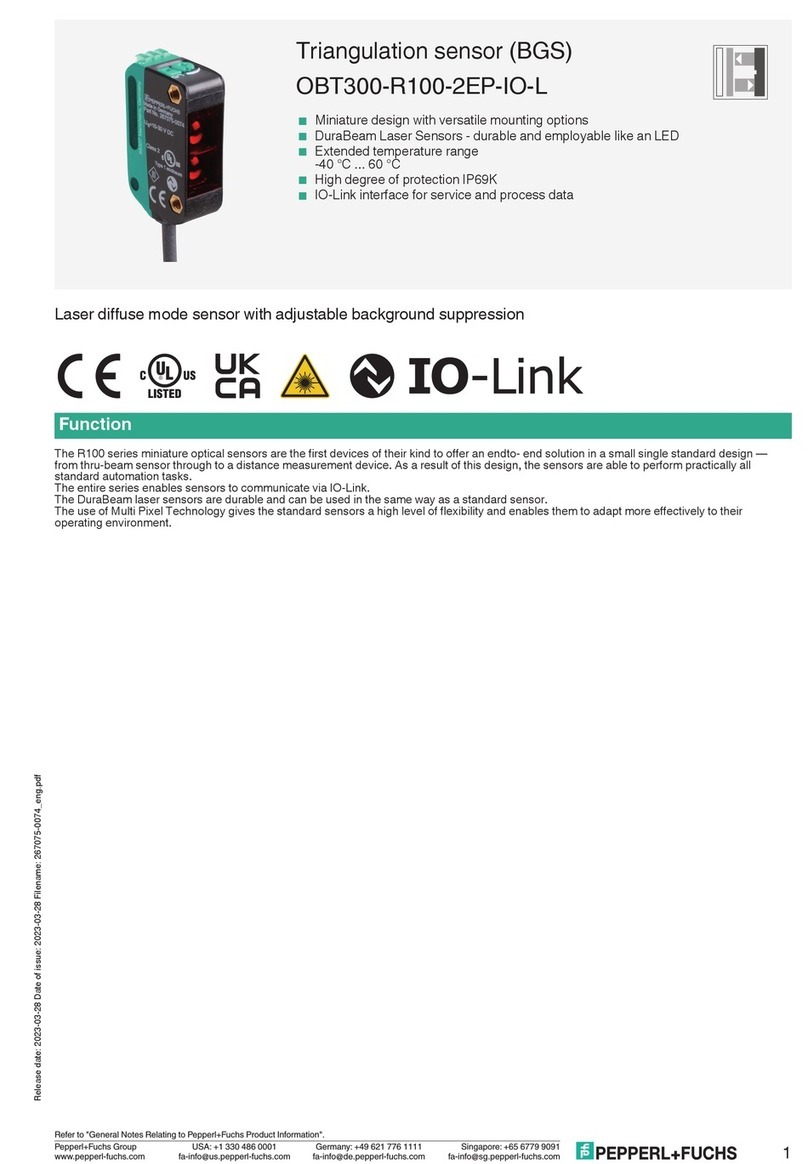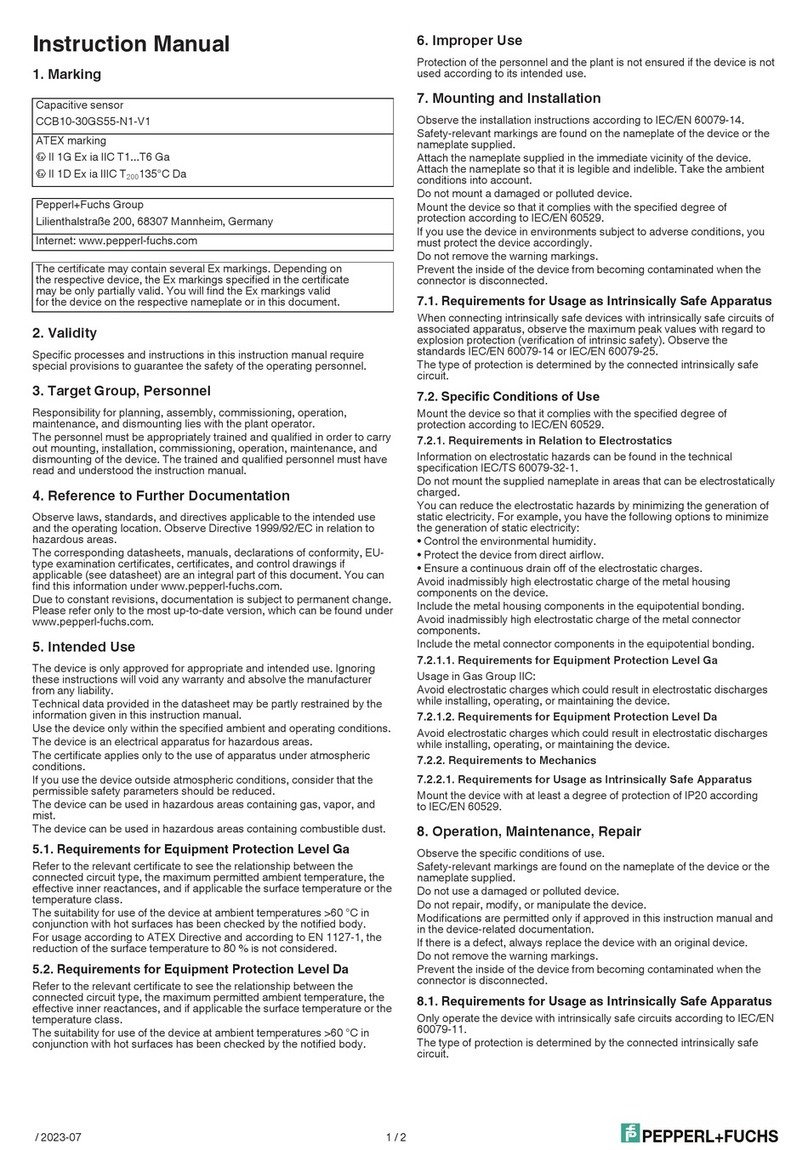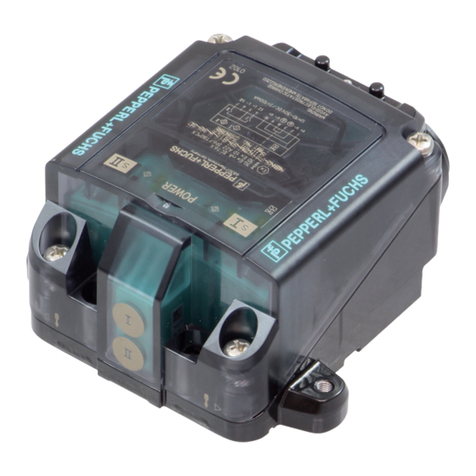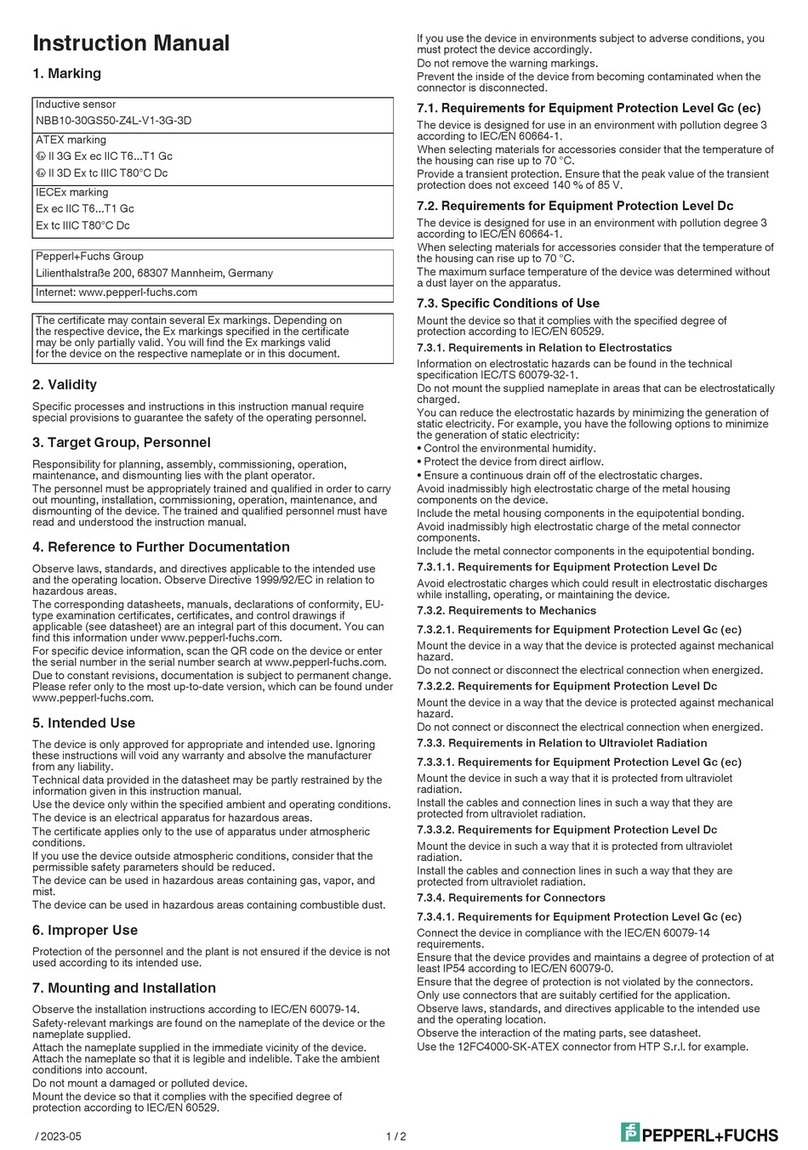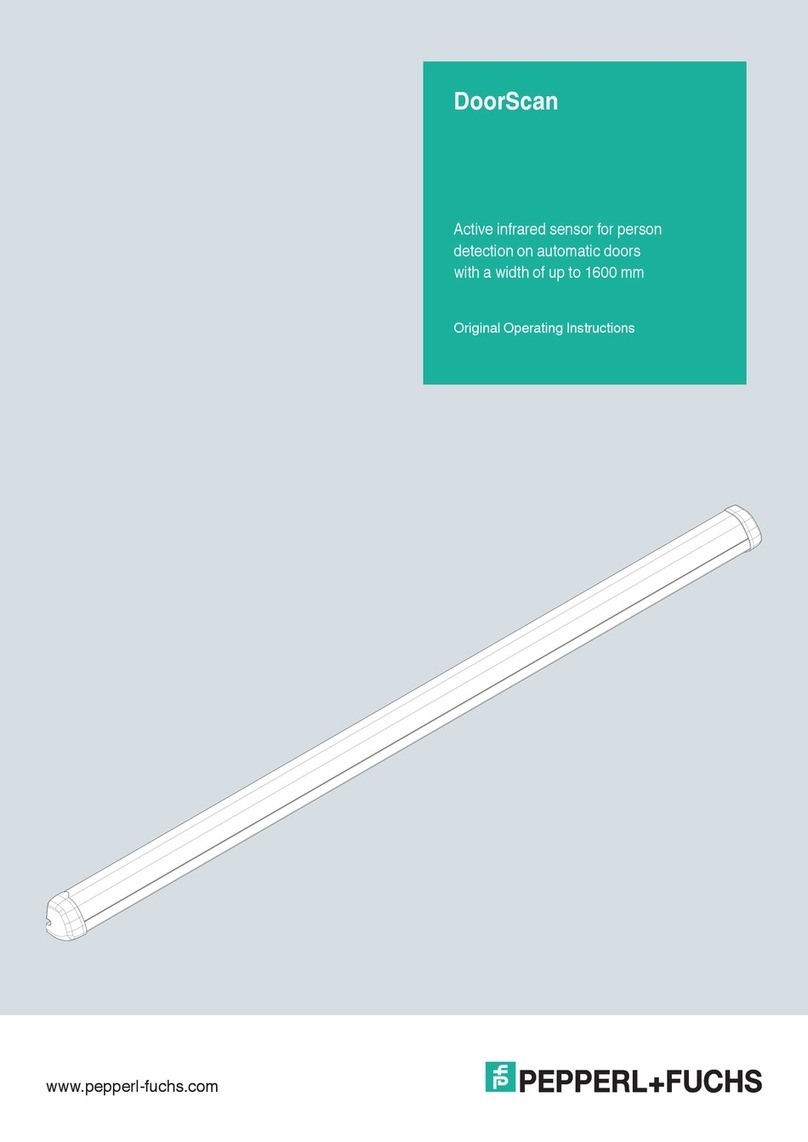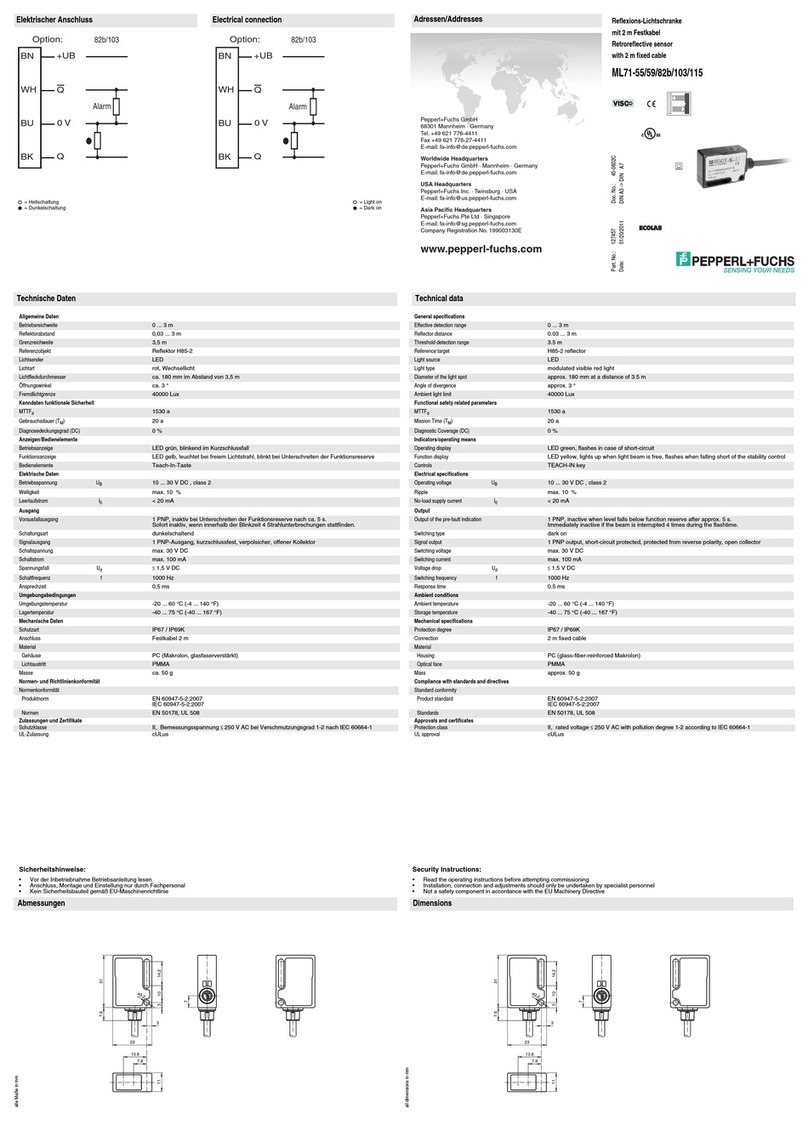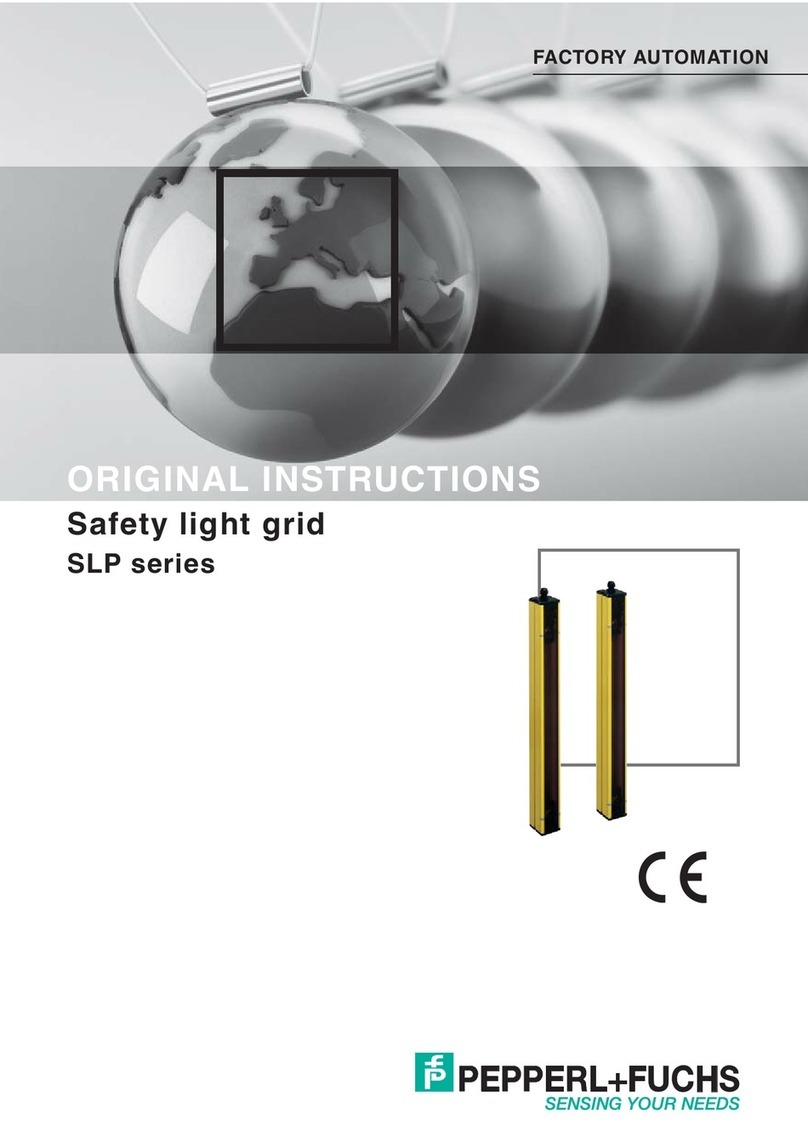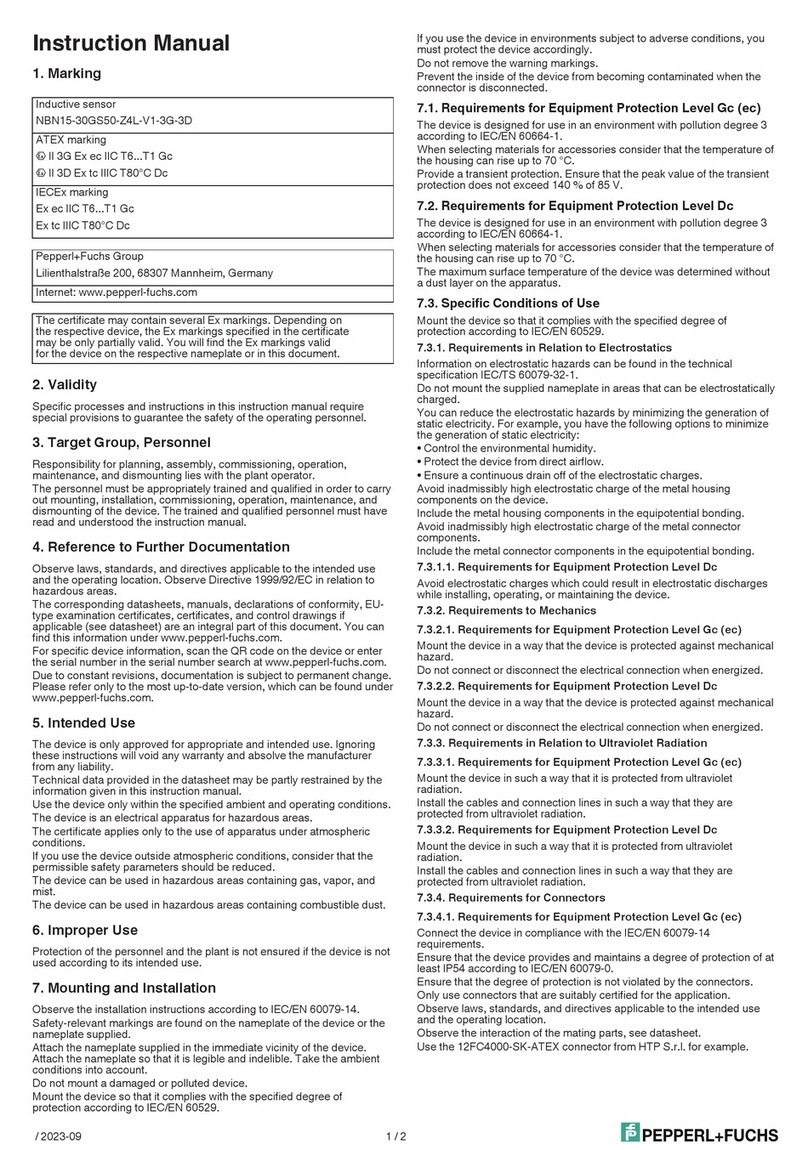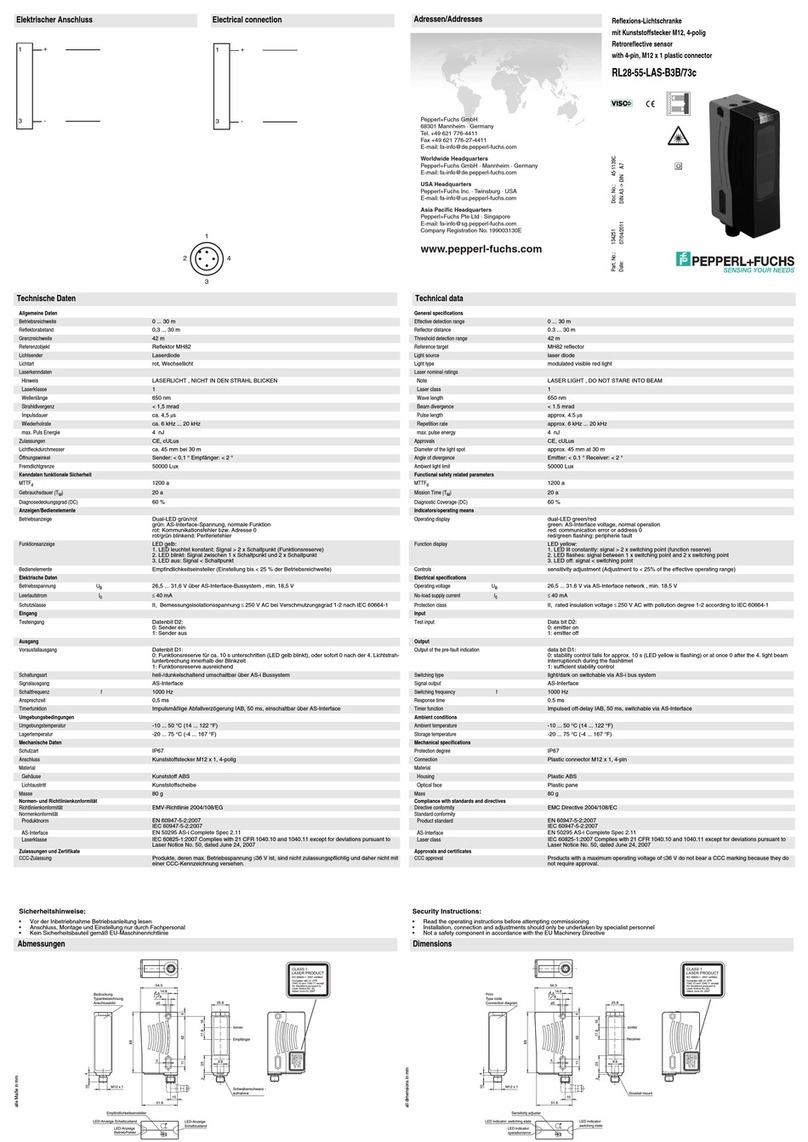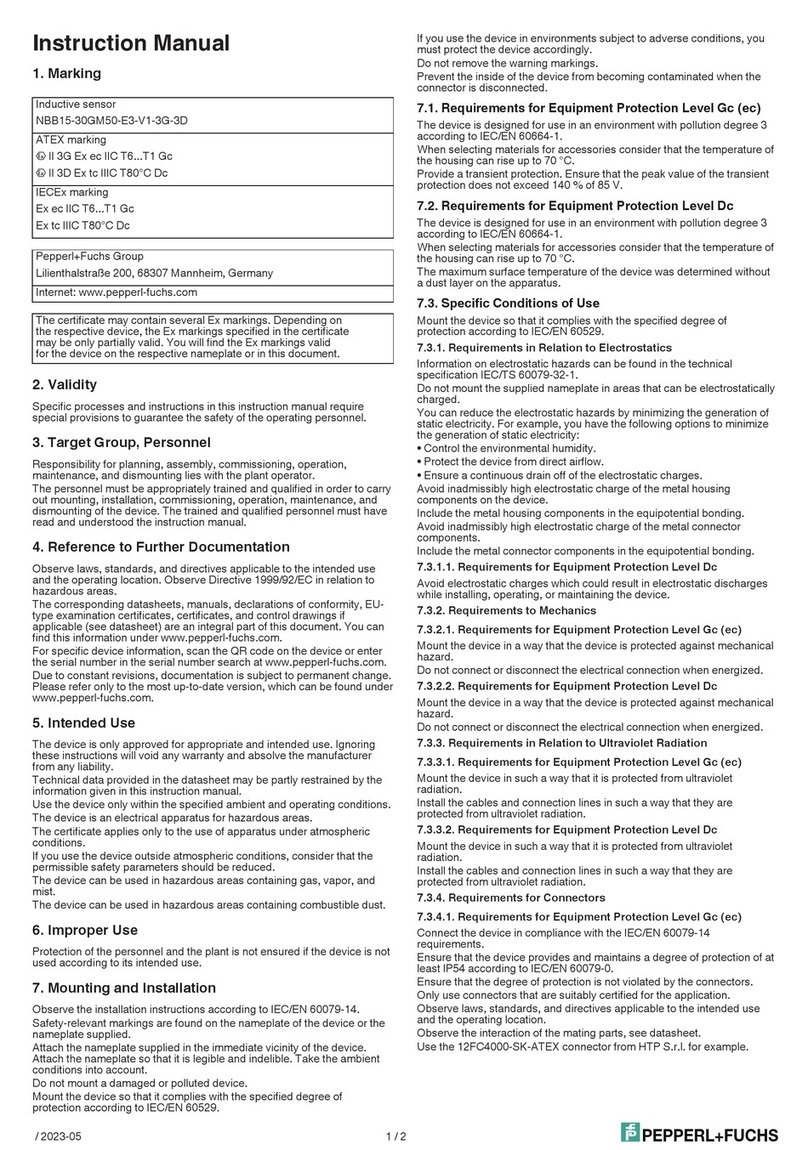
Adressen / Addresses / Adresses / Direcciónes / Indirizzi
Contact
Pepperl+Fuchs GmbH · 68301 Mannheim · Germany · Tel. +49 621 776-4411 · Fax +49 621 776-27-4411 · E-mail: a-in [email protected] uchs.comWorldwide He
adquarters:
Pepperl+Fuchs GmbH · Mannheim · Germany · E-mail: in [email protected]perl- uchs.com SA Headquarters: Pepperl+Fuchs Inc. · Twinsburg · USA · E-mail: a-in o@us.pepperl- uchs.com
Asia Pacific He
adquarters:
Pepperl+Fuchs Pte Ltd · Singapore · E-mail: a-in [email protected]l- uchs.com · Company Registration No. 199003130EFor more contact-adresses refer to the catalogue or internet: http://www.pepperl-fuchs.com
Beschreibung der Sensorfunktionen
Programmiervorgang
Der Sensor ist mit einem Schaltausgang mit zwei programmierbaren Schaltpunkten ausgestattet. Die Programmierung der Schaltpunkte und der
Ausgangsbetriebsarten kann au 3 verschiedene Arten vorgenommen werden:
- Mittels Programmiertaste des Sensors
- Durch Anschalten der Versorgungsspannung 0 V oder +UB an den Programmiereingang (nur ür die Programmierung der Schaltpunkte)
- Über die serielle Schnittstelle des Sensors. Diese Methode er ordert ein externes Inter acemodul.
Die Programmiermethoden über die Programmiertaste und mittels Programmiereingang sind untenstehend beschrieben. Für die Programmierung
über die serielle Schnittstelle des Sensors, siehe So twarebeschreibung. Die Programmierung der Schaltpunkte und der Sensorbetriebsarten er olgt
völlig unabhängig voneinander, ohne gegenseitige Beein lussung.
Hinweis:
- Die Möglichkeit der Programmierung besteht in den ersten 5 Minuten nach dem Einschalten und verlängert sich während des Programmierens.
Nach 5 Minuten ohne Programmiertätigkeit wird der Sensor gegen Programmieren verriegelt.
- An jeder Stelle der Programmierung besteht die Möglichkeit diese ohne Änderungen der Sensoreinstellung zu verlasen. Drücken Sie dazu die
Programmiertaste ür 10 s.
Programmierung der Schaltpunkte
Hinweis:
Eine blinkende rote LED während des Programmiervorgangs signaIisiert unsichere Objekterkennung. Korrigieren Sie in diesem Fall die Ausrichtung
des Objekts bis die gelbe LED blinkt. Nur so werden die Einstellungen in den Speicher des Sensors übernommen.
Programmierung der Schaltpunkte mittels Programmiertaste
Programmierung des nahen Schaltpunktes
1. Positionieren Sie das Objekt am Ort des gewünschten nahen Schaltpunktes
2. Drücken Sie die Programmiertaste ür 2 s (gelbe LED blinkt)
3. Drücken Sie die Programmiertaste kurz (grüne LED blinkt 3x zur Bestätigung). Der Sensor kehrt in den Normalbertrieb zurück.
Programmierung des fernen Schaltpunktes
1. Positionieren Sie das Objekt am Ort des gewünschten ernen Schaltpunktes
2. Drücken Sie die Programmiertaste ür 2 s (gelbe LED blinkt)
3. Drücken Sie die Programmiertaste ür 2 s (grüne LED blinkt 3x zur Bestätigung). Der Sensor kehrt in den Normalbertrieb zurück.
Programmierung der Schaltpunkte mittels Programmiereingang
Hinweise:
- Vor Beginn des Programmiervorgangs muss der Programmiereingang ür minsestens 2 s unbeschaltet sein.
- Wenn die Betriebsspannung (0V oder +UB) ür >10 s angelegt wird, kehrt der Sensor ohne Änderung der Einstellungen in den Normalbetrieb
zurück. Um eine er olgreiche Programmierung zu gewährleisten, lösen Sie die Verbindung zum Programmiereingang vor Ablau dieser Zeit.
- Wird der Programmiereingang nicht genutzt, sollte er dauerha t mit 0 V verbunden werden.
- Wird der Programmieradapter UB-PROG2 ür den Programmiervorgang verwendet, ist Taste A1 gleichbedeutend mit 0 V und Taste A2 mit +UB.
Stellen Sie in diesem Fall sicher, dass die mit dem Programmiereingang verbundene Ader am Ende des Sensorkabels o en ist (nicht au
Potenzial geklemmt ist).
Programmierung des nahen Schaltpunktes
1. Positionieren Sie das Objekt am Ort des gewünschten nahen Schaltpunktes
2. Verbinden Sie 0 V ür 2 s mit dem Programmiereingang (gelbe LED blinkt, danach blinkt die grüne LED 3x zur Bestätigung). Dann kehrt der
Sensor in den Normalbertrieb zurück.
Programmierung des fernen Schaltpunktes
1. Positionieren Sie das Objekt am Ort des gewünschten ernen Schaltpunktes
2. Verbinden Sie +UB ür 2 s mit dem Programmiereingang (gelbe LED blinkt, danach blinkt die grüne LED 3x zur Bestätigung). Dann kehrt der
Sensor in den Normalbetrieb zurück.
Programmierung der Sensorbetriebsarten
Der Sensor ver ügt über eine 3-stu ige Programmierung der Sensorbetriebsarten. In dieser Routine können Sie programmieren:
1. Ausgangs unktion
2. Ausgangsverhalten
3. Schallkeulen orm
Die Programmierung er olgt nacheinander. Um von einer Programmier unktion in die nächste zu wechseln, drücken Sie die Programmiertaste ür 2 s.
Drücken Sie die Programmiertaste für 5 s, um in die Programmierroutine der Sensorbetriebsarten zu gelangen.
Programmierung der Ausgangsfunktion
1. Die grüne LED blinkt nun. Die Anzahl der Blinkimpulse zeigt die aktuell programmierte Ausgangs unktion an:
1x: Schaltpunkt unktion
2x: Fenster unktion
3x: Hysterese unktion.
2. Drücken Sie kurz die Programmiertaste, um nacheinander durch die Ausgangs unktionen zu navigieren und wählen Sie so die gewünschte
Ausgangs unktion.
3. Drücken Sie die Programmiertaste ür 2 s zum Speichern, und um in die Programmierroutine ür das Ausgangsverhalten zu wechseln.
Programmierung des Ausgangsverhaltens
1. Die gelbe LED blinkt nun. Die Anzahl der Blinkimpulse zeigt das aktuell programmierte Ausgangsverhalten an:
1x: Schließerverhalten
2x: Ö nerverhalten.
2. Drücken Sie kurz die Programmiertaste, um nacheinander durch die Ausgangsverhalten zu navigieren und wählen Sie so das gewünschte
Ausgangsverhalten.
3. Drücken Sie die Programmiertaste ür 2 s zum Speichern, und um in die Programmierroutine ür die Schallkeule zu wechseln.
Programmierung der Schallkeulenform
1. Die rote LED blinkt nun. Die Anzahl der Blinkimpulse zeigt die aktuell programmierte Schallkeulen orm an:
1x: schmal
2x: mittel
3x: breit.
2. Drücken Sie kurz die Programmiertaste, um nacheinander durch die Schallkeulen ormen zu navigieren und wählen Sie so die gewünschte
Schallkeulen orm.
3. Drücken Sie die Programmiertaste ür 2 s zum Speichern, und um in den Normalbetrieb zurück zu kehren.
Reset des Sensors auf Werkseinstellungen
Der Sensor bietet die Möglichkeit der Rücksetzung au die ursprünglichen Werkseinstellungen.
1. Schalten Sie den Sensor spannungs rei
2. Drücken Sie die Programmiertaste und halten Sie diese gedrückt
3. Schalten Sie die Versorgungsspannung zu (gelbe und rote LED blinken im Gleichtakt ür 5 s, danach blinken die gelbe und grüne LED im
Gleichtakt)
4. Lassen Sie die Programmiertaste los
Der Sensor arbeitet nun mit den ursprünglichen Werkseinstellungen.
Werkseinstellungen (Siehe Technische Daten.
Anzeigen
Der Sensor ver ügt über drei LEDs zur Zustandsanzeige.
#
Synchronisation
Der Sensor ist mit einem Synchronisationseingang zur Unterdrückung gegenseitiger Beein lussung durch remde Ultraschallsignale ausgestattet.
Wenn dieser Eingang unbeschaltet ist, arbeitet der Sensor mit intern generierten Taktimpulsen. Er kann durch Anlegen externer Rechteckimpulse und
durch entsprechende Parametrierung über die serielle Schnittstelle synchronisiert werden. Jede allende Impuls lanke triggert das Senden eines
einzelnen Ultraschallimpulses. Wenn das Signal am Synchronisationseingang ≥1 s Low-Pegel ührt, geht der Sensor in die normale, unsynchronisierte
Betriebsart zurück. Dies ist auch der Fall, wenn der Synchronisationseingang von externen Signalen abgetrennt wird.(siehe Hinweis unten)
Liegt am Synchronisationseingang ein High-Pegel > 1 s an, geht der Sensor in den Standby-Zustand. Dies wird durch die grüne LED angezeigt. In
dieser Betriebsart bleiben die zuletzt eingenommenen Ausgangszustände erhalten. Bitte beachten Sie bei externer Synchronisation die
So twarebeschreibung.
Hinweis:
Wird die Möglichkeit zur Synchronisation nicht genutzt, so ist der Synchronisationseingang mit Masse (0V) zu verbinden oder der Sensor mit einem
V1-Anschlusskabel (4-polig) zu betreiben.
Die Möglichkeit zur Synchronisation steht während des Programmiervorgangs nicht zur Ver ügung und umgekehrt kann während der Synchronisation
der Sensor nicht programmiert werden.
Folgende Synchronisationsarten sind möglich:
1. Mehrere Sensoren (max. Anzahl siehe Technische Daten) können durch ein aches Verbinden ihrer Synchronisationseingänge synchronisiert
werden. In diesem Fall arbeiten die Sensoren selbstsynchronisiert nacheinander im Multiplex-Betrieb. Zu jeder Zeit sendet immer nur ein
Sensor. (siehe Hinweis unten)
2. Mehrere Sensoren (max. Anzahl siehe Technische Daten) können durch ein aches Verbinden ihrer Synchronisationseingänge synchronisiert
werden. Einer der Sensoren arbeitet durch Parametrierung über die Sensorschnittstelle als Master, die anderen Sensoren als Slave. (siehe
Schnittstellenbeschreibung) In diesem Fall arbeiten die Sensoren im Master-/Slave-Betrieb zeitsynchron, d. h. gleichzeitig, wobei der Master-
Sensor die Rolle eines intelligenten externen Taktgebers spielt.
3. Mehrere Sensoren können gemeinsam von einem externen Signal angesteuert werden. In diesem Fall werden die Sensoren parallel getriggert
und arbeiten zeitsynchron, d. h. gleichzeitig. Alle Sensoren müssen durch Parametrierung über die Sensorschnittstelle au Extern parametriert
werden. Siehe So twarebeschreibung.
4. Mehrere Sensoren werden zeitversetzt durch ein externes Signal angesteuert. In diesem Fall arbeitet jederzeit immer nur ein Sensor extern
synchronisiert. (siehe Hinweis unten) Alle Sensoren müssen durch Parametrierung über die Sensorschnittstelle au Extern parametriert werden.
Siehe So twarebeschreibung.
5. Ein High-Pegel (+UB) bzw. ein Low-Pegel (-UB) am Synchronisationseingang versetzt den Sensor in den Standby-Zustand bei Extern-
Parametrierung.
Hinweis:
Die Ansprechzeit der Sensoren erhöht sich proportional zur Anzahl an Sensoren in der Synchronisationskette. Durch das Multiplexen lau en die
Messzyklen der einzelnen Sensoren zeitlich nacheinander ab. Der Synchronisationsanschluss der Sensoren lie ert bei Low-Pegel einen
Ausgangsstrom und belastet bei High-Pegel mit einer Eingangsimpedanz. Bitte beachten Sie, dass das synchronisierende Gerät olgende
Treiber ähigkeit besitzen muss:
Treiberstrom nach +UB ≥ n * High-Pegel/Eingangsimpedanz (n = Anzahl der zu synchronisierenden Sensoren)
Treiberstrom nach 0V ≥ n * Ausgangsstrom (n = Anzahl der zu synchronisierenden Sensoren).
Schallkeule breit
Allgemeine Informationen
Ergänzende In ormationen Schalterstellung des externen Programmieradapters:
"output load": pull-down
"output logic": inv
Normen- und Richtlinienkonformität
Normenkon ormität
Normen EN 60947-5-2:2007 + A1:2012
IEC 60947-5-2:2007 + A1:2012
Zulassungen und Zertifikate
UL-Zulassung cULus Listed, General Purpose
CSA-Zulassung cCSAus Listed, General Purpose
CCC-Zulassung Produkte, deren max. Betriebsspannung ≤36 V ist, sind nicht zulassungsp lichtig und daher nicht mit
einer CCC-Kennzeichnung versehen.
grüne LED gelbe LED rote LED
Im Normalbetrieb
störungs reie Funktion
Störung (z. B. Drucklu t)
ein
aus
Schaltzustand
behält letzten Zustand bei
aus
ein
Bei Programmierung der Schaltpunkte
Objekt detektiert
kein Objekt detektiert
Bestätigung der er olgreichen Programmierung
Warnung bei ungültiger Programmierung
aus
aus
3x blinkend
aus
blinkend
aus
aus
aus
aus
blinkend
aus
3x blinkend
Bei Programmierung der Betriebsart
Programmierung der Ausgangs unktion
Programmierung des Ausgangsverhaltens
Programmierung der Schallkeule
blinkend
aus
aus
aus
blinkend
aus
aus
aus
blinkend
Description of Sensor Functions
Programming procedure
The sensor eatures a single output with two programmable switch points. Programming the switch points and the operating mode can be done in three
di erent ways:
- via the sensor’s Programming Button
- by applying the supply voltage 0 V or +UB to the Program input (only or programming the switch points)
- via the serial inter ace, which requires an external inter ace adapter
Procedures or programming via the sensor's Programming Button and the Program input are described below. For programming using the serial inter ace,
please re er to the so tware manual. Switch points and operating modes can be programmed independently without in luencing each other
Note:
- Programming is enabled or 5 minutes a ter power-on. A ter 5 minutes without programming activity the programming eature will be locked.
- During any programming step it is possible to leave the programming routine without changing the sensor settings by pressing the Programming
Button or 10 s.
Programming the Switch Points
Note:
I the red LED lashes during the programming procedure, it indicates uncertain target detection. In this case, please correct the target alignment until the
yellow LED lashes. The new settings will only be stored in the sensor’s memory i the yellow LED lashes.
Programming Switch Points using the Internal Programming Button
Programming the Near Switch Point
1. Place the target at the desired near switch point position
2. Press the Programming Button or 2 s (yellow LED lashes)
3. Press the Programming Button brie ly (green LED lashes three times or con irmation). The sensor returns to normal operation.
Programming of the Far Switch Point
1. Place the target at the desired ar switch point position
2. Press the Programming Button or 2 s (yellow LED lashes)
3. Press the Programming Button or 2 s (green LED lashes three times or con irmation). The sensor returns to normal operation.
Programming Switch Points by using the Program input wire
Notes:
- Be ore entering program mode the program input wire must be open circuit or at least 2s.
- I potential (0V or +UB) is applied or >10 s the sensor resumes normal operation without changing settings. To ensure success ul programming,
disconnect the Program input be ore this 10 s time period elapses.
- I the program input is not used, the wire should be connected to 0 V.
- I programming adapter UB-PROG2 is used or the programming procedure, button A1 is assigned to 0 V and button A2 is assigned to +UB. Please
make sure, that the cordset’s wire, which is connected to the Program input is not connected (open circuit).
Programming the Near Switch Point
1. Place the target at the desired near switch point position
2. Apply 0 V to the Program input or 2 s (yellow LED lashes, then green LED lashes three times or con irmation). Then sensor returns to normal
operation.
Programming the Far Switch Point
1. Place the target at the desired ar switch point position
2. Apply +UB to the Program input or 2 s (yellow LED lashes, then green LED lashes three times or con irmation). Then sensor returns to normal
operation.
Programming Modes of Operation
The sensor provides a three step routine to program the modes o operation. In this routine you can program:
1. Output unction
2. Output behavior
3. Beam width
Programming the modes is carried out sequentially. To toggle rom one mode to the next, press the Programming Button or 2 s.
Press the Programming Button for 5 s to enter the operating modes programming routine.
Programming the output function
1. The green LED lashes. The number o lashes indicates the current output unction:
single lash: Switch point output unction
double lash: Window output unction
triple lash: Hysteresis output unction.
2. Press the Programming Button brie ly to toggle sequentially through these output unctions and select the desired mode.
3. Press the Programming Button or 2 s to save and enter the programming routine or output behavior
Programming the output behavior
1. The yellow LED lashes. The number o lashes indicates the current output behavior:
single lash: Normally Open (NO)
double lash: Normally Closed (NC).
2. Press the Programming Button brie ly to toggle sequentially through these output behaviors and select the desired mode.
3. Press the Programming Button or 2 s to save and enter the programming routine or beam width.
Programming the beam width
1. The red LED lashes. The number o lashes indicates the current beam width setting:
single lash: narrow
double lash: medium
triple lash: wide.
2. Press the Programming Button brie ly to toggle sequentially through these beam shapes.
3. Press the Programming Button or 2 s to save and exit the operating modes programming routine.
Reset Sensor to Factory Settings
The sensor has a eature to reset to actory settings
1. Disconnect the sensor rom power supply
2. Press and hold the Programming Button
3. Connect Sensor to power supply (yellow and red LED lash simultaneously or 5 s then yellow and green LED lash simultaneously)
4. Release Programming Button
The sensor now operates with de ault actory settings.
Factory settings (See technical data)
Display
The sensor is provided with three LEDs to indicate various conditions.
#
Synchronization
This sensor eatures a synchronization input or suppressing ultrasonic mutual inter erence ("cross talk"). I this input is not connected, the sensor will
operate reewheeling using internally generated clock pulses. It can be synchronized by applying an external square wave or by means o appropriate
programming via the serial inter ace. Each alling edge o the synchronization pulse triggers transmission o a single ultrasonic pulse. I the synchronization
signal remains low or ≥ 1 second, the sensor will revert to normal operating mode. Normal operating mode can also be activated by opening the signal
connection to the synchronization input.(See note below)
I the synchronization input goes to a high level or > 1 second, the sensor will switch to standby mode, indicated by the green LED. In this mode, the output(s)
will remain in the last valid output state. When using the external synchronization eature, please re er to the so tware description.
Note:
I the option or synchronization is not used, the synchronization input has to be connected to ground (0V) or the sensor has to be operated via a V1 cordset
(4-pin).
The synchronization unction cannot be activated during programming mode and vice versa.
The following synchronization modes are possible:
1. Several sensors (max. number see technical data) can be synchronized together by interconnecting their respective synchronization inputs. In this
case, each sensor alternately transmits ultrasonic pulses in a sel multiplexing mode. No two sensors will transmit pulses at the same time. (See note
below)
2. Several sensors (max. number see technical data) can be synchronized together by interconnecting their respective synchronization inputs. Due to
programming via the sensors inter ace one sensor acts as a master device, all the others as slave devices. (see description o the inter ace) In this
master / slave mode the sensors are triggered in parallel and are synchronized by a common synchronization pulse, provided by the master device.
3. Multiple sensors can be controlled by the same external synchronization signal. In this mode the sensors are triggered in parallel and are
synchronized by a common external synchronization pulse. All sensors must be parameterized or external synchronization by means o the sensor
inter ace. See so tware description.
4. A separate synchronization pulse can be sent to each individual sensor. In this mode the sensors operate in external multiplex mode. (See note
below). All sensors must be parameterized or external synchronization by means o the sensor inter ace. See so tware description.
5. A high level (+UB) or a low level (-UB)on the synchronization input switches the sensor to standby mode i it is parameterized or external
synchronization.
Note:
Sensor response times will increase proportionally to the number o sensors that are in the synchronization string. This is a result o the multiplexing o the
ultrasonic transmit and receive signal and the resulting increase in the measurement cycle time.The sensors syncronization input delivers an output current
in case o low level and burdens with its input impedance in case o high level. Please pay attention that the synchronizing device needs to have that driver
capability:
driver current against +UB ≥ n * high-level/input impedance (n = number o sensors to be synchronized)
driver current against 0V ≥ n * output current (n = number o sensors to be synchronized).
Beam width wide
General information
Supplementary in ormation Switch settings o the external programming adapter:
"output load": pull-down
"output logic": inv
Compliance with standards and directives
Standard con ormity
Standards EN 60947-5-2:2007 + A1:2012
IEC 60947-5-2:2007 + A1:2012
Approvals and certificates
UL approval cULus Listed, General Purpose
CSA approval cCSAus Listed, General Purpose
CCC approval CCC approval / marking not required or products rated ≤36 V
Green LED Yellow LED Red LED
During Normal operation
Proper operation
Inter erence (e.g. compressed air)
On
O
Switching state
remains in previous state
O
On
During Switch Point Programming
Object detected
No object detected
Con irmation a ter Programming
Programming ailed warning
O
O
Triple lashing
O
Flashing
O
O
O
O
Flashing
O
Triple lashing
During Sensor Mode Programming
Programming the output unction
Programming the output behaviour
Programming the beam width
Flashing
O
O
O
Flashing
O
O
O
Flashing
